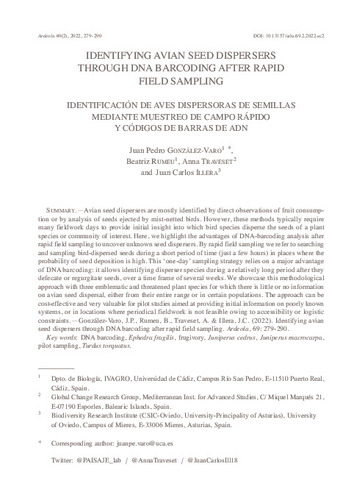Identifying Avian Seed Dispersers through DNA Barcoding After Rapid Field Sampling
Autor(es) y otros:
Fecha de publicación:
Versión del editor:
Citación:
Descripción física:
Resumen:
Avian seed dispersers are mostly identified by direct observations of fruit consumption or by analysis of seeds ejected by mist-netted birds. However, these methods typically require many fieldwork days to provide initial insight into which bird species disperse the seeds of a plant species or community of interest. Here, we highlight the advantages of DNA-barcoding analysis after rapid field sampling to uncover unknown seed dispersers. By rapid field sampling we refer to searching and sampling bird-dispersed seeds during a short period of time (just a few hours) in places where the probability of seed deposition is high. This ‘one-day’ sampling strategy relies on a major advantage of DNA barcoding: it allows identifying disperser species during a relatively long period after they defecate or regurgitate seeds, over a time frame of several weeks. We showcase this methodological approach with three emblematic and threatened plant species for which there is little or no information on avian seed dispersal, either from their entire range or in certain populations. The approach can be cost-effective and very valuable for pilot studies aimed at providing initial information on poorly known systems, or in locations where periodical fieldwork is not feasible owing to accessibility or logistic constraints.
Avian seed dispersers are mostly identified by direct observations of fruit consumption or by analysis of seeds ejected by mist-netted birds. However, these methods typically require many fieldwork days to provide initial insight into which bird species disperse the seeds of a plant species or community of interest. Here, we highlight the advantages of DNA-barcoding analysis after rapid field sampling to uncover unknown seed dispersers. By rapid field sampling we refer to searching and sampling bird-dispersed seeds during a short period of time (just a few hours) in places where the probability of seed deposition is high. This ‘one-day’ sampling strategy relies on a major advantage of DNA barcoding: it allows identifying disperser species during a relatively long period after they defecate or regurgitate seeds, over a time frame of several weeks. We showcase this methodological approach with three emblematic and threatened plant species for which there is little or no information on avian seed dispersal, either from their entire range or in certain populations. The approach can be cost-effective and very valuable for pilot studies aimed at providing initial information on poorly known systems, or in locations where periodical fieldwork is not feasible owing to accessibility or logistic constraints.
Descripción:
Martínez-de la Puente, J., Díez-Fernández, A., Soriguer, R.C., Rambozzi, L., Peano, A., Meneguz, P.G. & Figuerola, J. (2021). Are malaria-infected birds more attractive to mosquito vectors? Ardeola, 68: 251-264. https://doi.org/10.13157/arla.68.1.2021.fo1
ISSN:
Patrocinado por:
This research was funded by a Spanish ‘Ramón y Cajal’ fellowship (RYC2017-22095) awarded to JPGV. BR has been supported by a Spanish ‘Juan de la Cierva – Incorporación’ fellowship (IJCI-2017-33475) and a postdoctoral grant from the University of Cádiz (UCA/REC17VPCT/2021). JCI was funded by two regional GRUPIN grants from the Regional Government of Asturias (Ref.: IDI/2018/000151 and Ref.: AYUD/2021/51261)
Colecciones
- Artículos [37544]
- Biología de Organismos y Sistemas [776]
- Investigaciones y Documentos OpenAIRE [8416]
Ficheros en el ítem




